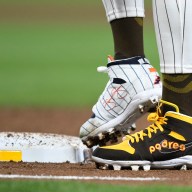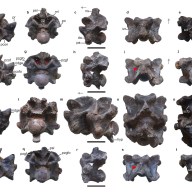For golf equipment enthusiasts, there’s a sense that the quest for a perfect bag can never be achieved. It’s hard to perfectly fit and fine tune those 14 clubs to maximize your game.
I’ve spent a fair amount of time this summer learning about club fitting, TrackMan and all the ins and outs of flex, weight, launch, spin, etc. But the one variable that hadn’t come up often was torque. Shaft maker UST Mamiya is changing that.
For a long time, conventional wisdom said that the better the player and the faster the swing, the lower the torque should be. Torque plays a role in stabilizing the club from twisting during the course of the golf swing. But rarely has torque previously factored heavily into the fitting, because most high-end shafts are at the low end of the torque spectrum.
With its new Proforce VTS series of shafts, UST Mamiya offers the same shaft in three different levels of torque, varying slightly between the different weight shafts. Black is the lowest (3.0 in the 6 series), Silver is the midrange (4.0) and Red is the highest torque (at a previously unheard of 5.0).
UST Mamiya analyzed my TrackMan data and sent along shafts that would match my “swing DNA.” All three were identical in characteristics, except for the torque. By keeping everything else the same, we could take the fitting another level deeper and find just the right torque for my swing.
“Swing DNA” is a phrase that UST Mamiya fitters use in their examination, because they find there’s more to look at than swing speed. They know that one golfer’s 115 mph swing could be smooth and fluid while another’s 115 mph swing can be violent and aggressive. It’s here that torque can make a difference.
Throughout my visit to Hot Stix for a general demonstration of fitting, we discussed how low torque would typically fit my swing, which is anything but elegant or smooth. But I entered the Proforce VTS fitting open minded and looked forward to seeing how each shaft would perform. As best as I could, thanks to an interchangeable adapter that plugs into a Titleist 910d2 driver head, I blind tested each (made possible by the graphics being on the underside of the shaft).
My first thoughts, at the driving range, without a launch monitor, just an eyeball test:
Proforce VTS Red: Felt great, the ball explodes off the face with this shaft unlike the others. I could work the ball nicely in either direction, but it was launching quite high and my miss was a monster hook.
Proforce VTS Silver: Very good feel, and a very controllable ball flight. Those big hooks from the Red were manageable draws. Working the ball left to right was difficult, but when I caught one, the ball flew high and long. This certainly felt like the shaft for me.
Proforce VTS Black: The lowest launch, but also the most likely to hit it high, right and stinky. Drawing this shaft took some effort, in turn leading me to overdo it and hit some nasty hooks. But playing for a slight cut would produce booming drives that flew forever. Hitting at the range made it tough to tell the exact distance of one driver versus the others, but I was afraid the Black was simply too inconsistent that day.
Next up, with some initial thoughts tucked away, I wanted to see what science said, so I returned to Hot Stix for a VTS session on TrackMan. The numbers, while close, easily ruled out the Red. That much torque, given my abrupt transition and other elements of my Swing DNA wasn’t the right fit. It actually spun less than the Silver or Black, but I had the lowest Smash Factor (a measure of how solidly you’re striking the ball) and the worst angle of attack. That added up to misses that were bigger, so I narrowed it to the Silver and Black.
Over the next 20 minutes or so, I hit one glorious drive after another with the Silver, a big booming draw that would start on the right edge of the rough and land on the left edge of the fairway. I followed that with drives with the Black that were much straighter, but my miss continued to be a push draw that neither me nor the fitters liked. However, the TrackMan numbers pointed to the Black being the best in terms of launch angle, spin and Smash Factor, and I was getting more distance out of it. But our eyes couldn’t be lying, it was obvious that the Silver was the best shaft for me that day.
I knew that I was on the right track, but something didn’t sit well knowing that all those great drives with the VTS Silver required me to play a 30-yard draw. I decided to see how it felt on the course, and sure enough, I wasn’t thrilled. Could it be that the TrackMan data really should trump my eyes?
“I’d say nine out of 10 people should use the data to choose their shaft,” Robb Schikner UST Mamiya’s Vice President of Sales and Marketing, told me. “I’d suggest you go with the launch monitor. Once you get used to hitting that shaft, and seeing a consistent ball flight, you’ll adjust your aiming points and targets and you’ll be better off.”
Like a soothsayer, Schikner was right.
The next time on out on my home course, which is tree-lined and requires the ability to work the ball quite often off the tee, I put the Black through the paces. Just like on the range, some real sizzling drives, but I continued to fight that push fade. Until I realized that I was setting up for the sweeping draw I’d hit with previous drivers, including the Silver VTS. Once I got comfortable hitting the ball straight and adjusting my alignment and targets, I’ve seen top-notch results. Low, piercing trajectory, the ability to hit a slight natural draw without losing the ability to cut it as needed, and without a doubt, less spin and in turn, less ballooning.
I asked Robb for some generalities on the different torques and he didn’t want to make sweeping generalizations since each person’s swing will produce slightly different results.
But, he says that the higher torque (the Red) increases launch angle, which in turn makes the driver more workable. He said that many of the PGA Tour players have opted for the Red for this very reason. Their golf swings are so tuned in that they can control a high-torque driver shaft and gain from the ability to work the ball better.
“The general trend is that the better the golfer, we’re seeing the higher the torque,” he said.
In the past, it’s unlikely these Tour pros would ever pick up a shaft with a torque in the 5+ range, because there wouldn’t be anything available that also fit the rest of their swing.
The lower torque, for a single digit handicapper like myself, seems to mask swing flaws and inconsistencies. There’s a psychological factor in play with the driver flying straighter, leading to more confidence, better swings, and eventually better play.
Conclusion: The UST Mamiya VTS shafts take driver fitting to a new level, and they might even change the industry. Introducing torque may have farther reaching effects than you could imagine, especially as players at the highest levels disprove conventional wisdom that lower is better. If it proves successful, you can bank on all manufacturers revisiting the idea of fitting for torque.
In terms of the shaft itself, the VTS performs better than anything I’ve ever swung. Considering it’s the most comprehensively tried and tested shaft I’ve ever had in the bag makes comparing it to previous clubs a bit apples to oranges. But I can say without hesititation, that if you’re serious about maximizing your potential and getting every yard from your driver, UST Mamiya’s VTS line should be on your must-hit list for any future fitting.
Get Yours: The Proforce VTS has been available in 2011 on Tour and through UST Mamiya’s TourSPX dealers, who are full-service fitting operations. You can expect to see them available through retailers later this year or in early 2012. There are talks under way to include the Proforce VTS in the available offerings for many OEM drivers, including Titleist’s red-hot 910D series. In the meantime, you can find a TourSPX dealer online here.















